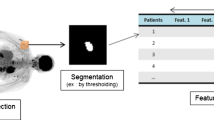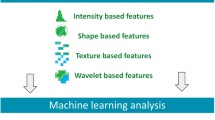Abstract
Feature selection for tumor treatment outcome prediction in PET scans amounts to determine the best predictors in order to classify treatment outcomes for unseen data. Several challenges have to be addressed, notably the dissensus about the most predictive radiomic features and the relatively small-sized and imbalanced training samples. To overcome these issues, we propose a multi-label learning (MLL) problem formulation that we associated to the technique of feature selection with shared information among multiple tasks. In fact, we opt to simultaneously mining the shared knowledge across similar tasks from MRI and fused PET/MRI images in order to sort PET features according to their relevancy. Then, by repeatedly training an SVM model, different feature sets are elected to be informative for each iteration. Thus, by associating these sets with their correspondents in other iterations, the MLL formulation is performed in order to adequately adapt both feature sets and training instances according to their fit with unseen data. The adaptive synthetic sampling technique is adapted to the framework of MLL data balance. After that, the global and local label correlation technique is used for multi-labeling, while taking into consideration the capacity of MLL on recommending the best sets of features and training instances. Finally, an SVM classifier is applied with both selected features and training sub-samples in order to output prediction results. Conducted experiments show that attributing each feature set to a particular set of instances and training the model with balanced subset of the whole training data allows to outperform relevant methods from the state of the art.















Similar content being viewed by others
References
Gillies, R.J., Kinahan, P.E., Hricak, H.: Radiomics: images are more than pictures, they are data. Radiology 278(2), 563–577 (2015)
Tan, S., Kligerman, S., Chen, W., Lu, M., Kim, G., Feigenberg, S., D’Souza, W., Suntharalingam, M., Lu, W.: Spatial–temporal \(^{18}\)FDG-PET features for predicting pathologic response of esophageal cancer to neoadjuvant chemoradiation therapy. Int. J. Radiat. Oncol. Biol. Phys. 85(5), 1375–1382 (2013)
El Naqa, I., Grigsby, P.W., Apte, A., Kidd, E., Donnelly, E., Khullar, D., Chaudhari, S., Yang, D., Schmitt, M., Laforest, R., Thorstad, W.L., Deasy, J.O.: Exploring feature-based approaches in PET images for predicting cancer treatment outcomes. Pattern Recognit. 42(6), 1162–1171 (2009)
Van De Wiele, C., Kruse, V., Smeets, P., Sathekge, M., Maes, A.: Predictive and prognostic value of metabolic tumour volume and total lesion glycolysis in solid tumours. Eur. J. Nucl. Med. Mol. Imaging 40(2), 290–301 (2013)
Haralick, R.M., Shanmugam, K., Dinstein, I.: Textural features for image classication. IEEE Trans. Syst. Man Cybern. 6, 610–621 (1973)
Amadasun, M., King, R.: Textural features corresponding to textural properties. IEEE Trans. Syst. Man Cybern. 19(5), 1264–1273 (1989)
Galloway, M.M.: Texture analysis using gray level run lengths. Comput. Graph. Image Process. 4(2), 172–179 (1975)
Tixier, F., Cheze-Le Rest, C., Hatt, M., Albarghach, N.M., Pradier, O., Metges, J.-P., Corcos, L., Visvikis, D.: Intratumor heterogeneity characterized by textural features on baseline 18F-FDG PET Images predicts response to concomitant radiochemotherapy in esophageal cancer. J. Nucl. Med. 52(3), 369–378 (2011)
Tan, S., Zhang, H., Zhang, Y., Chen, W., D’Souza, W.D., Lu, W.: Predicting pathologic tumor response to chemoradiotherapy with histogram distances characterizing longitudinal changes in 18F-FDG uptake patterns. Med. Phys. 40(10), 101707 (2013)
Sahran, S., Albashish, D., Abdullah, A., Shukor, N.A., Pauzi, S.H.: Absolute cosine-based SVM-RFE feature selection method for prostate histopathological grading. Artif. Intell. Med. 87, 78–90 (2018)
Sanchez, A., Raya, L., Mohedano-Munoz, M.A., Rubio-Sanchez, M.: Feature selection based on star coordinates plots associated with eigenvalue problems. Vis. Comput. (2020). https://doi.org/10.1007/s00371-020-01793-w
Lee, P.Y., Loh, W.P., Chin, J.F.: Feature selection in multimedia: the state-of-the-art review. Image Vis. Comput. 67, 29–42 (2017)
Sbei, A., ElBedoui, K., Barhoumi, W., Maksud, P., Maktouf, C.: Hybrid PET/MRI co-segmentation based on joint fuzzy connectedness and graph cut. Comput. Methods Progr. Biomed. 149, 29–41 (2017)
Sbei, A., ElBedoui, K., Barhoumi, W., Maktouf, C.: Gradient-based generation of intermediate images for heterogeneous tumor segmentation within hybrid PET/MRI scans. Comput. Biol. Med. 119, 103669 (2020)
Yang, Y., Ma, Z., Hauptmann, A.G., Sebe, N.: Feature selection for multimedia analysis by sharing information among multiple tasks. IEEE Trans. Multimed. 15(3), 661–669 (2012)
Chen, X., Wasikowski, M.: Fast: a ROC-based feature selection metric for small samples and imbalanced data classification problems. In: ACM SIGKDD International Conference on Knowledge Discovery and Data Mining, pp. 124–132 (2008)
Kira, K., Rendell, L.A.: The feature selection problem: traditional methods and a new algorithm. In: 10th National Conference on Artificial Intelligence: AAAI, vol. 2, pp. 129–134 (1992)
Whitney, A.W.: A direct method of nonparametric measurement selection. IEEE Trans. Comput. 100(9), 1100–1103 (1971)
Pudil, P., Novovicova, J., Kittler, J.: Floating search methods in feature selection. Pattern Recognit. Lett. 15(11), 1119–1125 (1994)
Mi, H., Petitjean, C., Dubray, B., Vera, P., Ruan, S.: Robust feature selection to predict tumor treatment outcome. Artif. Intell. Med. 64(3), 195–204 (2015)
Tibshirani, R.: Regression shrinkage and selection via the LASSO. J. R. Stat. Soc. Ser. B (Methodol.) 58(1), 267–288 (1996)
Niedzielski, J.S., Yang, J., Liao, Z., Gomez, D.R., Stingo, F., Mohan, R., Martel, M.M., Briere, T.M., Court, L.R.: \({18F}\)-fluorodeoxyglucose positron emission tomography can quantify and predict esophageal injury during radiation therapy. Int. J. Radiat. Oncol. Biol. Phys. 96(3), 670–678 (2016)
Wang, H., Nie, F., Huang, H., Risacher, S., Ding, C., Saykin, A.J., Shen, L.: Sparse multi-task regression and feature selection to identify brain imaging predictors for memory performance. In: 2011 International Conference on Computer Vision, pp. 557–562 (2011)
Suk, H.I., Lee, S.W., Shen, D.: The Alzheimer’s disease neuroimaging initiative. Deep sparse multi-task learning for feature selection in Alzheimer’s disease diagnosis. Brain Struct. Funct. 221(5), 2569–2587 (2016)
Lian, C., Ruan, S., Denux, T.: An evidential classifier based on feature selection and two-step classification strategy. Pattern Recognit. 48(7), 2318–2327 (2015)
Shafer, G.: A Mathematical Theory of Evidence, vol. 42. Princeton University Press, Princeton (1976)
Lian, C., Ruan, S., Denoux, T., Vera, P.: Outcome prediction in tumour therapy based on Dempster–Shafer theory. In: IEEE International Symposium on Biomedical Imaging, pp. 63–66 (2015)
Lian, C., Ruan, S., Denoeux, T., Jardin, F., Vera, P.: Selecting radiomic features from FDG-PET images for cancer treatment outcome prediction. Med. Image Anal. 32, 257–268 (2016)
Wu, J., Lian, C., Ruan, S., Mazur, T.R., Mutic, S., Anastasio, M.A., Grigsby, P.W., Vera, P., Li, H.: Treatment outcome prediction for cancer patients based on radiomics and belief function theory. IEEE Trans. Radiat. Plasma Med. Sci. 3(2), 216–224 (2018)
Desbordes, P., Ruan, S., Modzelewski, R., Sebastien, V., Vera, P., Isabelle, G.: Feature selection for outcome prediction in oesophageal cancer using genetic algorithm and random forest classifier. Comput. Med. Imaging Graph. 60, 42–49 (2017)
Desbordes, P., Ruan, S., Modzelewski, R., Pineau, P., Vauclin, S., Gouel, P., Michel, P., Sebastien, V., Fiore, F.D., Vera, P., Isabelle, G.: Predictive value of initial FDG-PET features for treatment response and survival in esophageal cancer patients treated with chemo-radiation therapy using a random forest classifier. PLoS ONE 12(3), e0173208 (2017)
Amyar, A., Ruan, S., Gardin, I., Chatelain, C., Decazes, P., Modzelewski, R.: 3-D RPET-NET: development of a 3-D pet imaging convolutional neural network for radiomics analysis and outcome prediction. IEEE Trans. Radiat. Plasma Med. Sci. 3(2), 225–231 (2019)
Dario, G., Roberto, C., Federica, V., Comelli, A., Pavone, A., Salvaggio, L., Galia, M., Midiri, M., Lagalla, R., Salvaggio, G.: PI-RADS 3 lesions: role of prostate MRI texture analysis in the identification of prostate cancer. Curr. Probl. Diagn. Radiol. (2019). https://doi.org/10.1067/j.cpradiol.2019.10.009
Comelli, A., Stefano, A., Coronnello, C., Russo, G., Vernuccio, F., Cannella, R., Salvaggio, G., Lagalla, R., Barone, S.: Radiomics: A new biomedical workflow to create a predictive model. In: Annual Conference on Medical Image Understanding and Analysis. Springer, Cham, pp. 225–231 (2020)
Vallieres, M., Freeman, C.R., Skamene, S.R., Naqa, I.E.: A radiomics model from joint FDG-PET and MRI texture features for the prediction of lung metastases in soft-tissue sarcomas of the extremities. Phys. Med. Biol. 60(14), 5471–5496 (2015)
Clark, K., Vendt, B., Smith, K., Freymann, J., Kirby, J., Koppel, P., Stephen Moore, S., Phillips, D., Maffitt, M.P., Tarbox, L., Prior, F.: The cancer imaging archive (TCIA): maintaining and operating a public information repository. J. Digit. Imaging 26(6), 1045–1057 (2013)
Obozinski, G., Taskar, B., Jordan, M.I.: Joint covariate selection and joint subspace selection for multiple classification problems. Stat. Comput. 20(2), 231–252 (2010)
Wang, S., Chang, X., Li, X., Sheng, Q.Z., Chen, W.: Multi-task support vector machines for feature selection with shared knowledge discovery. Signal Process. 120, 746–753 (2016)
Yang, Y., Wu, F., Nie, F., Shen, H.T., Zhuang, Y., Hauptmann, A.G.: Web and personal image annotation by mining label correlation with relaxed visual graph embedding. IEEE Trans. Image Process. 21(3), 1339–1351 (2011)
Chawla, N.V., Bowyer, K.W., Hall, L.O., Kegelmeyer, W.P.: SMOTE: synthetic minority over-sampling technique. J. Artif. Intell. Res. 16, 321–357 (2002)
He, H., Bai, Y., Garcia, E.A., Li, S.: ADASYN: adaptive synthetic sampling approach for imbalanced learning. In: IEEE International Joint Conference on Neural Networks, pp. 1322–1328 (2008)
Zhang, M.L., Zhou, Z.H.: A review on multi-label learning algorithms. IEEE Trans. Knowl. Data Eng. 26(8), 1819–1837 (2014)
Boutell, M.R., Luo, J., Shen, X., Brown, C.M.: Learning multi-label scene classification. Pattern Recognit. 37(9), 1757–1771 (2004)
Zhang, M.L., Zhou, Z.H.: ML-KNN: a lazy learning approach to multi-label learning. Pattern Recognit. 40(7), 2038–2048 (2007)
Furnkranz, J., Hullermeier, E., Mencia, E., Brinker, K.: Multilabel classification via calibrated label ranking. Mach. Learn. 73(2), 133153 (2008)
Read, J., Pfahringer, B., Holmes, G., Frank, E.: Classifier chains for multi-label classification. Mach. Learn. 85(3), 333–359 (2011)
Huang, S., Zhou, Z.: Multi-label learning by exploiting label correlations locally. In: AAAI Conference on Artificial Intelligence, pp. 945–955 (2012)
Zhu, Y., Kwok, J.T., Zhou, Z.H.: Multi-label learning with global and local label correlation. IEEE Trans. Knowl. Data Eng. 30(6), 1081–1094 (2017)
Somol, P., Novovicova, J.: Evaluating stability and comparing output of feature selectors that optimize feature subset cardinality. IEEE Trans. Pattern Anal. Mach. Intell. 32(11), 1921–1939 (2010)
Jung, Y., Kim, J., Eberl, S., Fulham, M., Feng, D.D.: Visibility-driven PET-CT visualisation with region of interest (ROI) segmentation. Vis. Comput. 29(6–8), 805–815 (2013)
Kuanar, S., Athitsos, V., Mahapatra, D., Rao, K.R., Akhtar, Z., Dasgupta, D.: Low dose abdominal CT image reconstruction: an unsupervised learning based approach. In: 2019 IEEE International Conference on Image Processing (ICIP), pp. 1351–1355 (2019)
Kuanar, S., Athitsos, V., Pradhan, N., Mishra, A., Rao, K.R.: Cognitive analysis of working memory load from EEG, by a deep recurrent neural network. In: 2018 IEEE International Conference on Acoustics, Speech and Signal Processing (ICASSP), pp. 2576–2580 (2018)
Hermessi, H., Mourali, O., Zagrouba, E.: Deep feature learning for soft tissue sarcoma classification in MR images via transfer learning. Expert Syst. Appl. 120, 116–127 (2019)
Guo, Z., Li, X., Huang, H., Guo, N., Li, Q.: Deep learning-based image segmentation on multimodal medical imaging. IEEE Trans. Radiat. Plasma Med. Sci. 3(2), 162–169 (2019)
Sathish, D., Kamath, S., Prasad, K., Kadavigere, R.: Role of normalization of breast thermogram images and automatic classification of breast cancer. Vis. Comput. 35(1), 57–70 (2019)
Li, X., Shen, H., Zhang, L., Zhang, H., Yuan, Q., Yang, G.: Recovering quantitative remote sensing products contaminated by thick clouds and shadows using multitemporal dictionary learning. IEEE Trans. Geosci. Remote Sens. 52(11), 7086–7098 (2014)
Acknowledgements
The authors would like to thank Dr. Albert Comelli from the Ri.MED Foundation, Palermo, Italy, for his valuable contribution in testing the DIFS technique on the studied dataset.
Author information
Authors and Affiliations
Corresponding author
Additional information
Publisher's Note
Springer Nature remains neutral with regard to jurisdictional claims in published maps and institutional affiliations.
Rights and permissions
About this article
Cite this article
Sbei, A., ElBedoui, K., Barhoumi, W. et al. Adaptive feature selection in PET scans based on shared information and multi-label learning. Vis Comput 38, 257–277 (2022). https://doi.org/10.1007/s00371-020-02014-0
Accepted:
Published:
Issue Date:
DOI: https://doi.org/10.1007/s00371-020-02014-0




